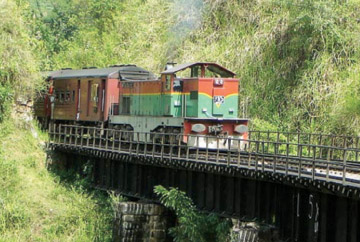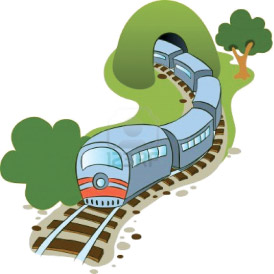The Sri Lanka
Railway
The Sri Lanka Railway, originally known as the Ceylon Government
Railways, was conceived in the 1850s as an instrument to develop and
unify Sri Lanka. The railway service began operations in 1864, with the
construction of the Main Line from Colombo to Ambepussa, 54 kilometres
to the east. The Railway was initially built in Ceylon to transport tea
and coffee from the hill country to Colombo.
 For many years, transporting such goods was the main source of income
on the line. With time and population growth, however, passenger traffic
increased. In the 1960s, passenger traffic overtook freight as the main
source of revenue. For many years, transporting such goods was the main source of income
on the line. With time and population growth, however, passenger traffic
increased. In the 1960s, passenger traffic overtook freight as the main
source of revenue.
The railway is now primarily engaged in the transport of passengers,
especially commuters to and from Colombo, thereby reducing road
congestion.
The first train ran on December 27, 1864. The line was officially
opened for traffic on October 2. 1865. The Main Line was extended in
stages with service to Kandy in 1867, to Nawalapitiya in 1874, to
Nanu-Oya in 1885, to Bandarawela in 1894, and to Badulla in 1924.
Other lines were completed in due course to link the country: the
Matale Line in 1880, the Coast Line in 1895, the Northern Line in 1905,
the Mannar Line in 1914, the Kelani Valley Line in 1919, the Puttalam
Line in 1926, and the Batticaloa and Trincomalee Lines in 1928.
Thereafter, no major extensions were added to the Sri lankan (Ceylon)
Railway Routes as the British left the country for native rule.
Class M6 locomotives haul the Udarata Menike Train from Badulla to
Colombo. Until 1953, Sri Lankan Railway served with steam locomotives
and enhanced its service to more power with diesel locomotives. Various
types of diesel locomotives were added to the service.
The Sri Lanka Railway network
The Railway network comprises nine lines radiating from Colombo,
which connect most major population and industrial centre.
The Main Line starts from Colombo and runs east and north past the
rapidly developing centres of Ragama, Gampaha, Veyangoda, and
Polgahawela. At Rambukkana, the Main Line begins its steep climb into
the hills upcountry. Between Balana and Kadugannawa, the track clings to
the side of sheer cliffs, offering passengers spectacular views of
Batalegala ('Bible' Rock).
The Main Line then continues its climb through the scenic tea
country, connecting busy local market centres at Gampola, Nawalapitiya,
and Hatton before reaching Nanu-Oya. This is the connection to the
former colonial resort of Nuwara-Eliya, which is still popular because
of its temperate climate, its many classic hotels, and British-style
gardens. The Main Line continues its ascent to the summit at Pattipola,
6,226 feet above sea level, before descending past Bandarawela to
Badulla. Upcountry, passengers are rewarded with delightful views of tea
gardens, mountains and valleys, cascading torrents and waterfalls.
 The Matale Line branches off the Main Line at Peradeniya Junction,
near the world-famous Peradeniya Botanical Gardens. It connects to Kandy,
home of the Sri Dalada Maligawa, which houses the Sacred Tooth Relic of
the Buddha, before descending to Matale. The Matale Line branches off the Main Line at Peradeniya Junction,
near the world-famous Peradeniya Botanical Gardens. It connects to Kandy,
home of the Sri Dalada Maligawa, which houses the Sacred Tooth Relic of
the Buddha, before descending to Matale.
The Coast Line runs south from Colombo, following the edge of the
Indian Ocean, and offering passengers views of tropical beaches and
coconut palms.
This line links the regional towns of Moratuwa, Panadura, and
Kalutara South, as well as popular beach resorts at Aluthgama,
Ambalangoda, and Hikkaduwa. The line continues past Galle, which is
famous for its historic and well-preserved Dutch Fort, before
terminating at Matara.
The Kelani Valley Line extends from Colombo south and east to
Avissawella. This was originally built as a narrow gauge line and was
converted to dual gauge between 1991 and 1997.
The Puttalam Line branches off the Main Line at Ragama, extends north
past Negombo, an important regional town and tourist centre, and links
other busy market towns and fishing villages.
The Northern Line branches northward from the Main Line at
Polgahawela, passing Kurunegala, the capital of Wayamba Province, before
continuing to the historic cultural and religious centre of Anuradhapura.
This city was established in the 4th century B.C. and contains many
sites of religious and archaeological interest. The service is now
curtailed beyond Vavuniya and on the Mannar Line.
The Batticaloa Line branches eastward from the Northern Line at Maho,
to Polonnaruwa, site of an ancient capital in the 11th century and home
to many historic monuments.
The Trincomalee Line branches north and east from the Batticaloa Line
at Gal-Oya Junction and extends to Trincomalee.
- Wikipedia
|


